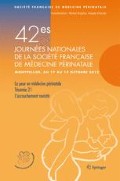Résumé
L’étude de la morbidité maternelle comme suivi de la santé maternelle est proposée en relais de l’étude de la mortalité maternelle. évaluer la prise en charge des pathologies composant la morbidité maternelle est un projet ambitieux pour proposer des pistes d’amélioration au niveau régional et local. Ces pistes d’amélioration pourraient se décliner en : Dépister, Orienter, Anticiper, Coordonner, Communiquer.
Preview
Unable to display preview. Download preview PDF.
Références
Danel I, Berg C, Johnson CH, Atrash H (2003) Magnitude of maternal morbidity during labor and delivery: United States, 1993–1997. Am J Public Health 93: 631–634
Tunçalp O, Hindin M, Souza J, et al. (2012) The prevalence of maternal near miss: a systematic review. BJOG 119: 653–661
Zhang WH, Alexander S, Bouvier-colle MH, Macfarlane A, the MOMS-B Group (2005) Incidence of severe pre-eclampsia, postpartum haemorrhage and sepsis as a surrogate marker for severe maternal morbidity in a European population-based study: the MOMS-B survey. Br J Obstet Gynaecol 112: 89–96
Watersone M, Bewley S, Wolfe C (2001) Incidence and predictors of severe obstetric morbidity: case-control study. BMJ 322: 1089–1093
Zwart JL, Richters JM, De Vries JIP (2008) Severe maternal morbidity during pregnancy, delivery and puerperium in the Netherlands: a nationwide population-based study of 371000 pregnancies. Br J Obstet Gynaecol 115: 842–850
Rapport du Comité national d’experts sur la mortalité maternelle (CNEMM)-2001–2006 (2010) Disponible en ligne. http://www.invs.sante.fr/publications
Lewis G (2011) The Confidential Enquiry into Maternal and Child Health (CEMACH). Saving Mother’s Lives: reviewing maternal death to make motherhood safer, 2006–2008. London: The eighth Report on Confidential Enquiries into Maternal Deaths in the United Kingdom. Available online at: http://www.cemach.org.uk
Oackley C, Child A, Jung B, et al. (2003) Expert consensus document on management of cardiovascular diseases during pregnancy. Eur Heart J 24: 761–781
Siu SC, Sermer M, Colman JM, et al. (2001) Prospective multicenter study of pregnancy outcomes in women with heart disease. Circulation 104: 515–521
Jastrow N, Meyer P, Khairy P, et al. (2011) Prediction of complications in pregnant women with cardiac diseases referred to a tertiary center. Int J Cardiol 151: 209–213
Bell R, Bailey K, Cresswell T, et al. (2008) Trends in prevalence and outcomes of pregnancy in women with pre-existing type I and type II diabetes. BJOG 115: 445–452
Mahmud, Mazza (2010) Preconceptional care of women with diabetes: a review of current guideline recommendations. BMC Women’s Health 10: 1–7
Arendas K, Qiu Q, Gruslin A (2008) Obesity in pregnancy: pre-conceptional to postpartum consequences. J Obstet Gynaecol Can 30: 477–488
Mhyre JM, Bateman BT, Leffert LR (2011) Influence of patient comorbidities on the risk of near-miss maternal morbidity or mortality. Anesthesiology 115: 963–972
Kiely DG, Condliffe R, Webster V, et al. (2010) Improved survival in pregnancy and pulmonary hypertension using a multiprofessional approach. BJOG 117: 565–574
Eller AG, Bennett MA, Sharshiner, et al. (2011) Maternal morbidity in cases of placenta accreta managed by a multidisciplinary care team compared with standard obstetric care. Obstet Gynecol 117: 331–337
Gao H, Mc Donnell A, Harrisson D A, et al. (2007). Systematic review and evaluation of physiological track and trigger warning systems for identifying at risk patients on the ward. Intensive Care Med 33: 667–679
Swanton RD, Al-Rawi S, Wee MY (2009) A national survey of obstetric early warning systems in the United Kingdom 18: 253–257
Singh S, Mc Glennan A, England A, et al. (2012) A validation study of the CEMACH recommended modified early obstetric warning system (MEOWS). Anaesthesia 67: 12–18
Goldhill DR, Mc Narry AF, Mandersloot G, McGinley A (2005) A physiologically-based early warning score for ward patients: the association between score and outcome. Anaesthesia 60: 547–553
Hémorragies du post-partum immédiat: recommandations pour la pratique clinique (2004) Disponible en ligne: http://www.cngof.asso.fr/d_pages/purpc_12.htm
Prise en charge multidisciplinaire des formes graves de prééclampsie (2009) Ann Fr Anesth Reanim 28: 275–281
Mathe ML, Morau E, Vernhet-Kovacsik H, et al. (2007) Impact of the new French clinical practice recommendations in embolization in postpartum and post-abortion hemorrhage: study of 48 cases. J Perinat Med 35: 532–537
Audureau E, Deneux-Tharaux C, Lefèvre P (2009) Practices for prevention, diagnosis and management of postpartum haemorrhage: impact of a regional multifaceted intervention. BJOG 116: 1325–1333
Circulaire DHOS/01/03/CNAMTS no 2006-151 du 30 mars 2006 relative au cahier des charges national des réseaux de santé en perinatalité
HAS (2009) Revue de morbi-mortalité (RMM). Paris: HAS http://www.has-sante.fr
Dupont C, Touzet S, Colin C, et al. (2009) Incidence and management of postpartum haemorrhage following the dissemination of guidelines in a network of 16 maternity units in France. Int J Obstet Anesth 18: 320–327
Branger B, Gillard P Monrigal C, et al. (2011) Leçons et impact de deux audits sur les hémorragies du post partum dans les 24 maternités du réseau «Sécurité Naîtie Ensemble» in « Pays-de-la-Loire» area. J Gynecol Obstet Biol Reprod 40: 657–667
Huissoud C, du Mesnildot P, Sayegh I et al. (2009) La mise en oeuvre des codes couleurs réduit le délai décision naissance des césariennes urgentes. J Gynecol Obstet Biol Reprod 38: 51–59
Birch L, Jones N, Doyle PM, et al. (2007) Obstetric skills drills: evaluation of teaching methods. Nurse Educ Today 27: 915–922
Van Hanegem N, Miltenburg AS, Zwart JJ, et al. (2011) Severe acute maternal morbidity in asylum seekers: a two-year nationwide cohort study in the Netherlands. Acta Obstet Gynecol Scand 90: 1010–1016
Author information
Authors and Affiliations
Rights and permissions
Copyright information
© 2013 Springer-Verlag France
About this chapter
Cite this chapter
Morau, E., Pastor, J., Criballet, G., Dubourdieu, J., Bonnal, A., Boulot, P. (2013). Réduire la morbidité maternelle. In: 42es Journées nationales de la Société Française de Médecine Périnatale (Montpellier 17–19 octobre 2012). Springer, Paris. https://doi.org/10.1007/978-2-8178-0385-2_21
Download citation
DOI: https://doi.org/10.1007/978-2-8178-0385-2_21
Publisher Name: Springer, Paris
Print ISBN: 978-2-8178-0384-5
Online ISBN: 978-2-8178-0385-2
eBook Packages: MedicineMedicine (R0)

